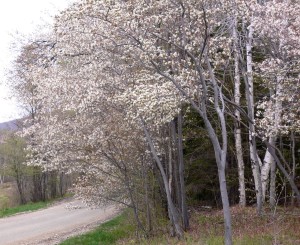Snow in spring
When the serviceberries bloom spring is here to stay!
Serviceberries are beautiful little trees that flourish along the hedgerows of the back-country roads of New England. For most of the year they are completely anonymous. But then, one spring morning, almost like magic they burst out of the shadows to cover themselves with delicate white flowers— like snow in springtime!
Serviceberries bloom before the forest leafs out. So it is an unforgettable sight on a misty morning, looking down a winding country road, to see their lacy white veil peeking out from under the still bare canopy of maple and ash.
This year I missed this enchantment in the valley, which happened around the first week of May, while we were away.
But up here in the mountains spring is always ten days late. What perfect timing: upon our return we were greeted by the sight of the serviceberries in full bloom in our garden and all along our quiet road.
But in even a few days the scene is already changing; as the forest above begins to leaf out, the roadside serviceberries retreat into obscurity beneath the larger trees.
Only in the garden, where I have planted them separately from other trees, do the serviceberries remain as part of the picture throughout the year.
Serviceberries in our gardens

In my garden I planted several Shadblow Serviceberries, (Amelanchier canadensis) to make a shady corner. This variety, with multiple stems, is like a very large shrub.
With delicate white flowers in springtime, as well as a lovely red color in the fall, serviceberries make delightful native trees for our gardens. And since they tolerate shade and remain relatively small, they are the perfect choice for those difficult shady spots, such as on the north side of the house. I also love to see them planted along a woodland edge as a gentle transition between the cultivated garden and the wild beyond.
A plant with many names
Serviceberries belong to the genus Amelanchier (part of the large Rose family) and actually have several common names, all with interesting origins:
The name ‘Serviceberry’ is because in New England they flower as burial services are held for people who died over the previous winter when the ground was too hard for family to dig their graves.
They are called Shad, or sometimes Shadbush, because they flower when the shad fish come up the rivers to spawn.
And finally they are known as Juneberries because their edible fruit ripens in June. Harvest the fruit for pies or for a fruit sauce over a nice yogurt. But hurry—you will be competing with the cedar-waxwings, who adore these blueberry-sized fruits.
Use whichever name you like—they all refer to the genus Amelanchier!
Within the Amelanchier genus there are actually several species which can be somewhat difficult to tell apart and which also cross-fertilize easily. Two species, both native to New England, the Allegheny Serviceberry (Amelanchier laevis) and the Downy Serviceberry (Amelanchier arborea) are small slender trees growing between 15’ and 35’ high when mature.
The Shadblow serviceberry (Amelanchier canadensis) is shaped more like a large shrub and matures at just 12’ high and wide. And finally the Western Serviceberry (Amelanchier alnifolia) is a 10’ high shrub that is grown commercially for its fruit.
In addition to these species, there are several hybridized varieties— or cultivars as they are called in the horticultural trade—for the gardener to choose between. Look especially for Amelanchier ‘Autumn Brilliance’ for a nice fall color and Amelanchier x grandiflora with its larger flowers.
Loveliest of trees
Every spring, as I greet the flowering of our own native serviceberries, A.E.Houseman’s famous poem about the wild cherry trees of the English woodlands runs through my head:
Loveliest of trees, the cherry now
Is hung with bloom along the bough,
And stands about the woodland ride
Wearing white for Eastertide.
Now of my threescore years and ten,
Twenty will not come again,
And take from seventy springs a score,
It only leaves me fifty more.
And since to look at things in bloom
Fifty springs are little room,
About the woodlands I will go
To see the cherry hung with snow.
—A.E. HOUSEMAN
But, unlike the young poet, I do not have fifty more springs to enjoy. So I will live in the present and make the most of each and every spring as it is given to me. And each spring I cherish the beauty of our New England serviceberry, when it too is ‘hung with snow’.
